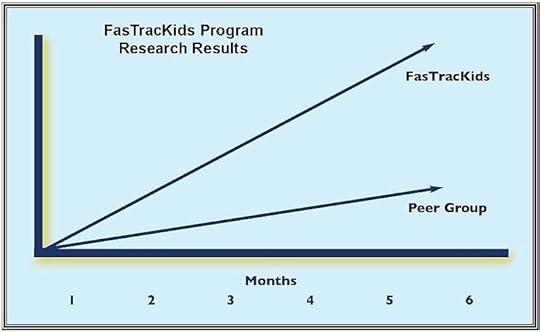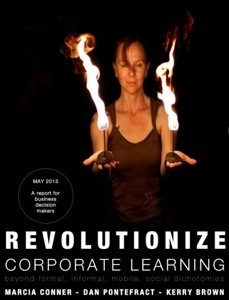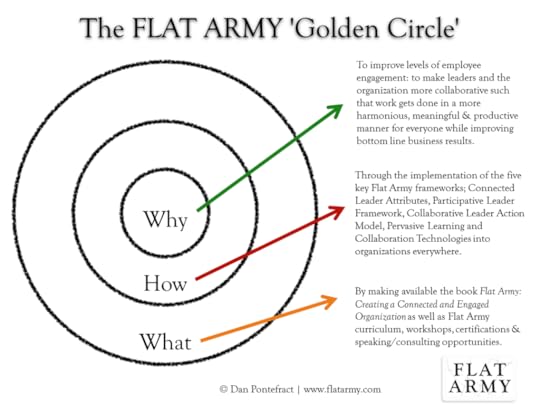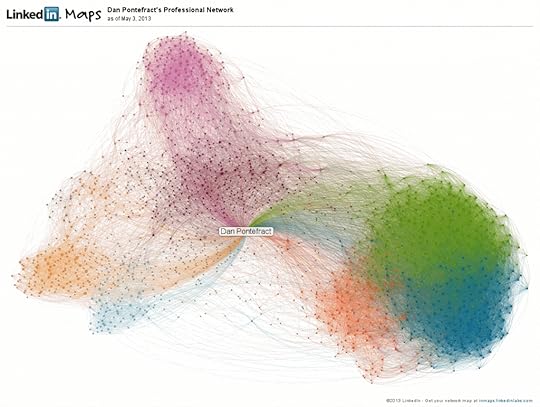Dan Pontefract's Blog, page 49
May 30, 2013
Steve Denning Nails It on Forbes: Paradigm Shift in Leadership and Management
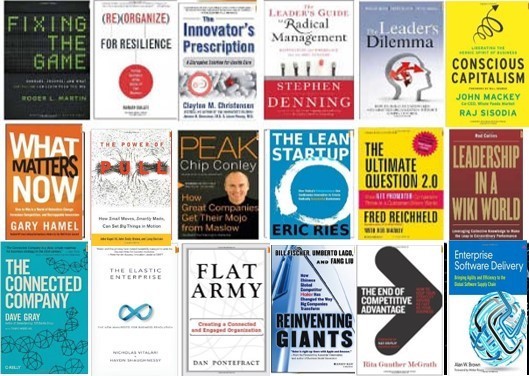
Photo courtesy of Forbes / Steve Denning
Steve Denning — one of those I look up to — was kind enough to include my book Flat Army: Creating a Connected and Engaged Organization as an example of recent literature that is helping to redefine leadership and management in the organization in his Forbes piece entitled, “The Management Revolution That’s Already Happening“.
Alongside 17 other books, Steve deftly explains the management revolution is underway, and that the Creative Economy is becoming a reality. (at least for some organizations) As he says, “ coherent constellation of fundamentally different principles in leadership and management has emerged.” Well, at least some of us are writing about it.
Flat Army contains a set of five frameworks for leaders AND the organization and when used in conjunction it’s my (biased) belief they can enable “an unobstructed flow of corporate commonality.” It’s shifting from a ‘culture of fears’ to a ‘culture of peers’.
One of the best paragraphs from Steve’s article (and review) is as follows:
The books are inspired by the idea that management must embody truth, both in what is said and how it is said. Clichés about the manipulation of systems and efficiency and incremental fixes will not do. The truth of our organizations, bitter and disheartening as it is, must be faced with honesty and imagination. These books do so with a force and a clarity that have not often been heard in management before.
I hope you have the chance to read the entire piece by Steve.
The books he is sourcing — including Flat Army — are as follows:
Fixing the Game (Roger Martin), What Matters Now (Gary Hamel), Reorganize for Resilience (Ranjay Gulati), The Power of Pull (John Hagel, John Seely Brown, Lang Davison), The Innovator’s Prescription (Clayton Christensen et al), The Leader’s Guide To Radical Management (Stephen Denning), The Leader’s Dilemma (Franz Röösli et al), Conscious Capitalism (John Mackey and Raj Sikodia), Peak (Chip Conley), The Lean Startup (Eric Ries), The Ultimate Question 2.0 (Fred Reichheld et al) and Leadership in a Wiki World (Rod Collins), The Elastic Organization (2012) by Nicholas Vitalari and Haydn Shaughnessy; The End of Competitive Advantage (2013) by Rita McGrath; Flat Army (2013) by Dan Pontefract: The Connected Organization (2013) by Dave Gray; Enterprise Software Delivery (2013) by Alan Brown and Reinventing Giants (2013) Bill Fischer et al.
302 total views, 28 views today
Related Posts:Future of Work: Add Open Leadership, Enterprise 2.0,…10 Free Copies of Flat Army … Participate to WinIt’s Time to Revolutionize Corporate LearningAnnouncing the Full Book Cover Jacket of Flat ArmyWHY I Wrote Flat Army: The Flat Army Golden Circle
May 29, 2013
Would You Send Your 6-Year Old to an MBA Program?
I’m not entirely certain what to make of this.
I got wind of a news report from Channel NewsAsia entitled, “MBA for Children” where three to six-year olds are enrolling into a pseudo MBA program for toddlers. Over 100,000 children have graduated from this program in Shanghai alone at a cost of roughly $590 USD per student. Watch the clip below:
Early on in the clip, a 6 year-old says, “I like to spend money when I was younger. Now I don’t.”
Wow.
What to make of this?
It seems this MBA for Children program in Shanghai is a derivative of a company based in Colorado, USA called FasTracKids who claim “that a significant number of three to six-year-old children enrolled in FasTracKids improved their vocabulary and social skills at a rate 100% to 150% times faster than their peers not enrolled in the program.”
They might need help on their use of graphs as their Y Axis looks a wee bit bare. See below.
That aside, I was personally shocked to view the clip above. 100,000 young Chinese toddlers are being (allegedly) fast-tracked towards the components of an MBA? It seems criminal.
And what of this parent company in Colorado? I’m sure Nancy Faunce, President and CEO of FasTracKids International knows what she is doing but I’m always a wee bit leery when I hear of programs (whether Nancy has a part in this or not) that are promoting the fast-tracking of young toddlers into MBA-like objectives.
It’s just so wrong on so many levels.
What do you think?
Related Posts:The Star Wars Mentoring ProgramOur Three Young Children Blog … Here’s WhyWhose Your Brian Reid?ABC – The 21st Century Learning ModelThe Remarkable Leadership Story of Conner & Cayden Long
May 21, 2013
Let’s N-Screen the Classroom
I used to be one of those educators.
There was a time when I wanted singular focus — an unadulterated fixation on my scintillating sermon — from every set of eyeballs when I was on stage in the classroom.
I was raised to believe the educator was the ‘sage on the stage’.
Maybe you still are?
If I were a high school teacher or a higher education professor today though, I’d be thinking twice about that philosophy. If I were a corporate trainer (I really do hate that term) or a Chief Learning Officer (wait a minute) I’d also be thinking if my approach might need to be altered.
Do educators of any stripe really believe learning solely happens through the lecture? Sure, there are times where said ‘sage’ should be pontificating from the pulpit to the pupils, but this doesn’t have to be the sole means of instruction.
But, let’s keep calm and carry on with the lecture in the classroom for a moment.
I don’t believe the lecture should be completely abandoned — and I do think we still need to tear down the walls of the classroom — but I do believe there is one issue that needs to be remedied once and for all.
Teachers, principals, professors, trainers, facilitators and lecturers alike … let’s N-Screen the classroom once and for all.
There was a time not too long ago when you might have attended a corporate training event and the facilitator made you drop off your mobile device at the back of the room. There was a non-descriptive box found at the back table and there may even have been a sign that read, “Park Cell Phones Here Please“. That same facilitator explained she needed your undivided attention because the forbidden fruit of your cell phone was ultimately going to cause you to perform a sin so you might as well separate yourself from the temptation. Unless of course there was a priest in your class, but that’s just a weird anomaly.
What about the various (and many) school boards who continue to ban cell phones, tablets or laptops from the classroom by students who are simply trying to enact their own BYOD — bring your own device — policy for themselves? Picture the following. Jasmin and Kuldeep show up on their first day at the new school. At the old school in a different part of the country they were able to bring their iPad’s into the classroom because their (then) forward thinking teacher and administration said it complemented their ‘pervasive learning‘ strategy. What happened on day one of the new school? Both Jasmin and Kuldeep were informed by the school principal that they need not bring in their iPad’s because “computer class happens every Day 3 on the schedule.”
You know it’s true.
Teachers, principals, professors, trainers, facilitators and lecturers alike … let’s N-Screen the classroom once and for all.
Let’s first acknowledge that although you may be a subject matter expert in your domain — whatever the domain — you still don’t know everything in your sphere of competence. Get over it. So, if you agree that you don’t know everything, why not let your students ‘plug in’ to complement what you’re saying or to reinforce the exercises or discussions you’ve put on the docket. Let your students use a device that is connected to the internet to not only help their own acumen but yours and the rest of the group.
That’s an example of N-Screen.
The group will undoubtedly be listening to you while you’re speaking and dancing around with your flipcharts and slides, but you will create a classroom environment that is both fluid and connected. It’s not a distraction, it’s simply another tentacle. It’s a reinforcement.
 Second, as a teacher, principal, professor, trainer, facilitator or lecturer, perhaps you can begin utilizing the N-Screen directly into your material. When I’m at a conference — whether as a speaker or an attendee — I love when there is an opportunity to engage through polling/quiz devices. That makes me feel a part of the process whether I’m the speaker or a bum in a seat.
Second, as a teacher, principal, professor, trainer, facilitator or lecturer, perhaps you can begin utilizing the N-Screen directly into your material. When I’m at a conference — whether as a speaker or an attendee — I love when there is an opportunity to engage through polling/quiz devices. That makes me feel a part of the process whether I’m the speaker or a bum in a seat.
If I’m actually teaching, I might alter my delivery to incorporate said mobile devices … presuming there is internet connectivity. Online scavenger hunt? Why not. A race to find three additional facts about the content you’re currently plowing through? Sure. The use of the web to complement an in-session group activity? You better believe it. Free surf time on the lecture at hand? Is it any different from allowing a smoke break and people talking about the class or content?
When I’m speaking, I’ve been known to tweet from the stage — while speaking — or give away free copies of Flat Army to those that have used a device to connect with others through the event hashtag. I scan the stream before I go on and head out into the audience at some point during my talk to drop off the book to the unsuspecting Twitter handle/peep.
These are examples of an N-Screen in the classroom.
To my brethren in the overarching teaching space; the digital device train has left the station long ago. No, not everyone has a device, but we’re getting close. And yes, etiquette, exemplary practice along do’s and don’ts might have to be taught and/or communicated. The question that remains is whether you are prepared to not only incorporate an N-Screen into your classroom but whether you are also going to modify the way you actually teach.
Are you ready to N-Screen the classroom?
Related Posts:“Since the way we run universities now is such a train…ABC – The 21st Century Learning ModelThe Wolf Pack and LearningI Have Never Worn a WatchOur Three Young Children Blog … Here’s Why
May 15, 2013
Air Canada Isn’t Collaborating With Its Employees
Early on in my career I took my first business trip to North Carolina where I participated in a ‘higher education’ conference. No, the conference wasn’t on the airplane although we were ‘higher’.
Because it was North Carolina there was even a pig roast. Sadly, I couldn’t find an apple.
 To get from Vancouver to Winston-Salem, I took planes interconnected by the Star Alliance family – Air Canada and United Airlines – and since that trip I very rarely diverge from the family.
To get from Vancouver to Winston-Salem, I took planes interconnected by the Star Alliance family – Air Canada and United Airlines – and since that trip I very rarely diverge from the family.
I’m a loyal customer racking up (according to a recent personalized infographic sent to me by Air Canada’s loyalty program) over 2 million miles of business. Suffice to say that I’ve had a few apples in various lounges unlike Miss Piggy in North Carolina from above.
I fly a lot with Air Canada, a little bit with United Airlines and when Europe or Asia beckons I hitch on to the Star Alliance family. That’s another way of saying I am well versed with the boarding drill as well. When it comes to Air Canada I have memorized (in both official languages) the recorded message that plays before boarding the plane. It’s no badge of honour; ask the goats.
But this past week I clued into something that alarms me on several levels.
Whilst getting ready to board a flight, standing at the front of the queue as I always do waiting for Air Canada Elite members to be called, I noticed a gal in a wheelchair to the right of the desk. She was inching her way to the agent’s desk desparately trying to part the sea of able bodied humans in her quest to board the plane.
 As I waited — watching the situation unfold — the Air Canada attendant summoned me to the desk so I could present my boarding pass and passport.
As I waited — watching the situation unfold — the Air Canada attendant summoned me to the desk so I could present my boarding pass and passport.
“Elites, let’s go,” he said motioning towards me and the queue of 20 odd people behind me.
Now, what normally happens on an Air Canada flight is a call out for those needing assistance — like our wheelchair friend, parents with kids, other requirements — before the ‘Elites’ parade down the boardwalk.
I wasn’t paying attention to the message that had just finished playing. I’d heard it a thousand times before.
I responded to the Air Canada agent rather foolishly and asked, “What about the woman in the wheelchair over there,” pointing to her as she approached the desk to his left.
“They changed everything a month ago,” remarked our clearly disengaged agent. “Elites now go first, then assisted help and then everyone else,” he concluded.
I was stunned.
 Mostly because I would never put myself ahead of anyone needing assistance but in the moment curiosity got the best of me.
Mostly because I would never put myself ahead of anyone needing assistance but in the moment curiosity got the best of me.
“Were you consulted on the decision,” I asked while fumbling (on purpose) with my passport and boarding pass.
“Do you think ‘they‘ would ask us first?” replied our now agitated agent. “We would never have suggested such a change.”
“We should let her through,” I retorted. “You clearly believe she should have that right — as do I — so let’s defy management’s orders.”
“Sir,” our agent said rather morosely, “I just can’t do it. It’s not my call.”
So, I had to submit my passport and boarding pass and enter the plane. As the ‘Elites’ planted themselves in the first 12 rows of the plane … only then did our wheelchair friend board.
 Of course it took another agent to literally carry (you might call it dragging) this woman to her seat. The process took about 5 minutes.
Of course it took another agent to literally carry (you might call it dragging) this woman to her seat. The process took about 5 minutes.
As she passed me I said, “Sorry you weren’t able to board first.”
Perking up with a smile that stretched from seat A to seat F she said, “Thanks, but it’s not a big deal. At least we’re on time.”
What character.
Why does this scenario irk me so?
I obviously only have one piece of evidence; the agent’s assertion that Air Canada management made a decision without the involvement of frontline customer facing employees. Perhaps there is more to the story. But if it’s true, it’s another classic example of fiefdom based management decision making without the input, ideas and innovation of its most important asset … its people.
I don’t mind the privileges that come with being an Elite member of the Star Alliance family but boarding a plane before those that need assistance is deplorable. It reeks of hierarchy and elitism and it’s plain wrong.
Dear Air Canada, how about you start collaborating as a unified team and avoid culture crushing and employee disengagement acts (not to mention public relations nightmares) like the one depicted above?
At a minimum, go back to the previous boarding announcements and boarding process.
Next time I fly with you I’ll even offer to be the announcer.
PS. I published this at 35,000 feet while on one of your competitors aircraft.
Related Posts:An Infographic Depicting Learning & Collaboration in…Did I Just Spam My Entire LinkedIn Network?Ya, I Cry at Work. Do You?Here’s to the Crazy OnesWhy Don’t We Tip Flight Attendants?
May 13, 2013
It’s Time to Revolutionize Corporate Learning
I spend a lot of time thinking, writing, speaking and working in my own personal and professional venn diagram of:
leadership development;
social collaborative tools; and
all things related to learning.
One of those pillars — the learning space — is where I started my career. I owe much of what I have today in my professional life to the learning space, be it K-12, higher education or the corporate sector.
But it’s the corporate learning sector in particular where I believe a new ‘learning arc’ must be developed. It must shift from Status Quo Ante (as was before) to Ad Meliora (toward better things).
Two of my dear friends and colleagues — Marcia Conner and Kerry Brown — were thinking the same way and so we put our collective heads together and developed a manifesto for you to read, and ideally, to be inspired by.
As we state,”the corporate learning field is in dire need of bravery, insight, creativity and boldness.”
Use as you see fit and imagine a new ‘learning arc’.
Imagine “learning nouveau”.
Revolutionize Corporate Learning: Beyond Formal, Informal, Mobile, Social Dichotomies by Marcia Conner, Dan Pontefract, and Kerry Brown.
From Slideshare you can download the full .pdf file. We are working on creating additional e-reader formats and will link to them here.
This work is licensed under a Creative Commons Attribution-NonCommercial-ShareAlike 3.0 Unported License. We want it to spread at no cost with attribution. Read, share, and use.
Please attribute as follows, with a link:
“Revolutionize Corporate Learning: Beyond Formal, Informal, Mobile, Social Dichotomies” by Marcia Conner, Dan Pontefract and Kerry Brown. May 2013. www.marciaconner.com/learning-nouveau/
Fascinated by that cover image? It was taken at the rehearsal for the wedding by Charlottesville wedding and portrait photographer April Bennett. Stephanie Helvin, the performer pictured, is part of the fire troupe Scintillation.
The ARC graphic is by Steve Kizer.
For information about this report or to begin, contact revolution@sensifygroup.com.
Related Posts:Flat Army Graphics on SlideshareAnnouncing the Full Book Cover Jacket of Flat Armyflat army bookThe Remarkable Leadership Story of Conner & Cayden LongFlat Army: Chapter 1 Overview
May 10, 2013
I’m Speaking at the World Business of Leadership Summit (WooT)
 I’m really excited to be speaking at the World Business of Leadership Summit but before I explain it and your chance to participate, I need to discuss reading.
I’m really excited to be speaking at the World Business of Leadership Summit but before I explain it and your chance to participate, I need to discuss reading.
I do a lot of reading.
I properly read a few books a month, I skim or power-read a few more and I’m always digesting blogs, research papers, articles, tweets and other social bits and bobs.
Perhaps you do the same?
In 2012, Pew Research asked Americans how many books they were reading on an annual basis and the results broke down as follows:
7% of Americans ages 16 and older read one book in the previous 12 months
14% had read 2-3 books in that time block
12% had read 4-5 books in that time block
15% had read 6-10 books in that time block
13% had read 11-20 books in that time block
14% had read 21 or more books in that time block
I guess I’m in the last bullet. Equally interesting, however, was how Americans were actually reading those books:
89% of book readers said they had read a printed book. This translates into 67% of all those ages 16 and older.
30% of book readers said they had read an e-book. This translates into 23% of all those ages 16 and older.
17% of book readers said they had listened to an audio book. This translates into 13% of all those ages 16 and older.
Can you read an audio book? (just kidding)
But what does reading have to do with me speaking at the World Business of Leadership Summit?
Over the last few years I’ve definitely increased the number of books I’ve been reading AND the number of conferences I’ve attended … but there is a catch.
Although my attendance at various conferences has increased … my participation at them has decreased.
How is that possible you knucklehead?
 I’ve been fortunate enough to have been invited to speak at a number of conferences over the last few years but because I have a real job and because I’ve increased the amount I’ve been reading, I typically go to a conference for the speaking opportunity, mingle with a few people, and then depart the conference to attend to my job or my reading … or life in general. (remember, I have three goats, Denise, a cycling hobby, etc.)
I’ve been fortunate enough to have been invited to speak at a number of conferences over the last few years but because I have a real job and because I’ve increased the amount I’ve been reading, I typically go to a conference for the speaking opportunity, mingle with a few people, and then depart the conference to attend to my job or my reading … or life in general. (remember, I have three goats, Denise, a cycling hobby, etc.)
I don’t actually get to listen to the other speakers or partake in some of the sessions.
But, coming up for me is the World Business of Leadership Summit and not only do I get to speak, I am going to attend (and participate in) several of the sessions found on the agenda.
It is a stellar event. (and I’ve read pretty much anything the speakers have previously written) There are 3 key reasons why I’m excited:
First off, the conference is spread out between June 17 and June 28. What else is cool? You don’t have to leave your home, office or wherever you happen to park your back side. It’s conducted through virtual tools the entire time. (just pay that internet bill)
Second, there are 1-3 sessions each day that you can attend. They are 100% live so you can interact with the speaker through a Q&A during or following the speaker’s timeslot. If you miss one … don’t worry, each of the sessions are recorded and you have up to 6 months to view them. (of course you miss out on the live interactions and you still have to pay that internet bill)
And finally there is the talent. Imagine a conference spread out over two working weeks where you can tap into the leadership minds of Jim Kouzes, Charlene Li, Chester Elton, Jody Thompson and Marshall Goldsmith amongst 20 others including … even me … from the comfort of your fingertips.
In a strictly platonic way of course.
If you’re interested, why not join me as a fellow attendee at the World Business of Leadership Summit.
Click the graphic below to register.
Related Posts:Review: SharePoint Conference 201110 Free Copies of Flat Army … Participate to WinFlexible Working WorksThe TED of all Learning Conferences #LWF12My Network is my Net Worth – Part II
May 7, 2013
Our Three Young Children Blog … Here’s Why
Those that know the intricacies of raising children also know there isn’t a day that goes by where we — as parents — aren’t judging.
We might be judging other parents, other children, other families, our better half, our own children … whatever the scenario, we’re judging. For the most part I hope we judge as a way of learning; questioning the ways and methods of others to better ourselves as a parent and as a human being. But, there are times we judge in somewhat cynical ways yearning for mistakes or saying to ourselves, “see, I told you so.”
Denise and I, as parents of the three goats (now aged, 10, 7 and 6) happily encourage them to publicly blog at their own domains:
www.clairepontefract.com
www.colepontefract.com
www.catepontefract.com
If you weren’t aware of it, are you now judging us?
If you were aware of it, are you still judging us? And is it a positive judgment or a negative one?
Why do we encourage (and ultimately allow) three young children who technically aren’t allowed to be on Facebook yet to publicly and openly blog?
There are a few reasons, so let us try to help with the rationale.
Writing, Motor and Memory Skills
First and foremost, this is a chance for the wee goats to practice their writing skills. Now we know the naysayers will say, “isn’t a pad and paper in a diary just as effective?” Sure … we encourage writing on paper as well through the creation of stories, booklets and cards. But hammering out a blog post using Gutenberg’s invention (whether on a laptop or their iPad) is both a writing skill as much as it’s a motor and memory skill as they learn the nuances of the QWERTY keyboard.
Motivation and Reward

The thrill of both pressing the button ‘publish‘ and knowing others might read their thoughts is both motivating and an intrinsic reward. Secondly, when a comment comes into their site as a result of their post from relatives, friends or yes even strangers, it both reinforces the motivation to write and it too creates a human connection reward. (plus the comments often have some form of learning in it as well for the goats)
Creativity
Blogging inspires creativity. At least in our house, there are no rules to what they might write about … so long as they are writing. Claire may write about a science experiment she conducted at home, Cole might want to create a presentation about sharks or Cate might want to regale you with her love of gymnastics. Whatever the case, they are encouraged to be creative and think ‘outside the box‘. There are no rules to what they can write about.
Everything is a Teaching Moment
Before you think Denise and I are complete lunatics, each post is vetted by the parents and often it’s a group writing exercise. With Denise and I both being educators, we’re using the act of blogging to help reinforce life values alongside life skills. Claire wanted to write about Rosa Parks (how cool is that?) and we had a great discussion about the Civil Rights movement at the dinner table that night. The same thing goes for War, which Cole wrote about once. Everything is a teaching moment.
Digital Literacy Skills
Of course, one of the easier skills we’re teaching is digital literacy. Claire started blogging when she was 7, Cole when he was 6 and Cate when she was 5 … and in each case, the goats are learning the ‘in’s and out’s’ of researching online, finding photos, checking facts (if applicable) as well as using the WordPress application on a laptop or as an app on the iPad.
Memory Keeper

As they continue their journey on the train of life, we reckon the blog posts that they write will (or perhaps can) act as a new way of documenting life itself. We hope it becomes a looking-glass to the past for each of them; a 2.0 way of tapping into past memories AND learning.
Each comment that comes into the sites are first vetted by the parents. Each post is ultimately pre-approved and there is a grammar and diction lesson that goes with it before publication.
And yes, we teach the goats about not only digital citizenship but digital safety. Sure, their names are ‘out there’ on the Internet for all to see, but safety goes hand-in-hand with our teaching efforts not only online but in the physical world too. To us, digital safety is an extension of physical safety.
We’re proud of the goats. We’re proud they love writing on their blogs. We don’t judge other parents for NOT encouraging (or allowing) their children to blog. But, if you are judging our parental choice on this particular matter, we hope you can now see (openly and publicly) why we’re encouraging it in the first place.
Thanks for reading.
Love, Dan & Denise
Related Posts:Interlocutors of 2012 (the goats are better for it)An 8 Year-Old Does Social LearningAutotelic: The Word of 2013The Recalibration of PlayIn Defense of Alexandra Samuel
May 6, 2013
WHY I Wrote Flat Army: The Flat Army Golden Circle
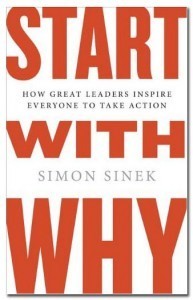 During some recent travelling, I used it as an opportunity to re-read (power read, you might say) fellow author and Speakers Spotlight brother Simon Sinek’s book “Start With Why: How Great Leaders Inspire Others To Take Action“.
During some recent travelling, I used it as an opportunity to re-read (power read, you might say) fellow author and Speakers Spotlight brother Simon Sinek’s book “Start With Why: How Great Leaders Inspire Others To Take Action“.
The fact it was first published in 2009 still gives me goose bumps. Simon was — and continues to be — ahead of his time. If you haven’t done so already, watch his TEDxPuget Sound Talk to get a condensed 18-minute version of his fantastic hypothesis and theory centered (literally) on The Golden Circle.
But you really should buy the book. (support those authors – we need new ribbons for the typewriter)
Aside from a man-crush on Simon and being highly influenced by his book, I was struck by the simplicity in his overarching point:
“People don’t buy WHAT you do, they buy WHY you do it.”
In my personal situation, the WHAT is clearly the Flat Army book — and the other pieces that are going along with it now or in the future — but the WHY is something I care deeply about.
I hope you do too.
I hope the WHY is why you might have bought the book in the first place, wanted to hear me speak, or continue showing up at this site.
I hope the WHY is why we might share a café, beer or an exchange on social media.
WHY art thou?
The WHY of Flat Army is simple … I’m fed up with the current state of leadership.
I’m fed up with current levels of disengagement in the organization. I’m fed up with pervasive levels of command and control in the organization. I’m fed up that although zillions of books have been written about ‘leadership’ over the past 30 years we have witnessed no discernible difference or improvement in employee engagement. I’m fed up that leaders have not truly recognized that an engaged employee will and can result in improved levels of productivity, customer satisfaction and yes … business results such as revenue or profit or shareholder return growth.
Put slightly more succinctly and with less ranting venom, the WHY of Flat Army is:
to improve levels of organizational and employee engagement and to make leaders and the organization more collaborative such that work gets done in a more harmonious, meaningful and productive manner for everyone.
My WHY is my passion for people. Whether employees, leaders or anyone in between, I believe the organization needs to become a mecca of togetherness.
My WHY is my wish for employee engagement to actually become the state in which there is reciprocal trust between the employee and leadership to do what’s right however, whenever and with whomever.
I wrote Flat Army inspired by the WHY that Simon puts forward in his ground-breaking book.
Now you know WHY … WHAT are you going to do to change employee engagement in your organization and/or leadership style?
Related Posts:Don’t Be a FOOL: Fear of Open Leadershipthe FLAT ARMY cheat sheetdan pontefractFlat Army Graphics on SlideshareAutotelic: The Word of 2013
May 2, 2013
My 1800+ LinkedIn Network Graphically Mapped
When it first came out I thought the LinkedIn Labs feature known as “InMaps” was really cool.
It still is really cool.
I haven’t used it in a couple of years, so after two days where I was on four planes and in three cities, I decided to vegetate on the couch and take another look at my LinkedIn network … graphically speaking.
Here’s what 1800 LinkedIn contacts look like and their relationship to me and each other.
Related Posts:Did I Just Spam My Entire LinkedIn Network?I’m Boycotting Mixtent, Here’s WhyMy Network is my Net Worth – Part III Unfriended You On Facebook. Are We Still Friends?Flat Army Book Launch Party … A Sea of Humanity
I Have Never Worn a Watch
Sir Ken Robinson remarked in his indelible TED Talks a few years ago that his daughter saw no reason to wear a watch. As he stated, “My teenage daughter doesn’t wear a watch. She says, ‘It’s a single-function device, how lame is that?”
The audience roared.
I have never worn a watch.
Ever.
Well aside from that Goofy watch when I was a wee tot.
To me, watches are a bit like children attractions in Las Vegas. What’s the point?
Given mobile phone penetration is near 90% in the Western world, isn’t it time we gave up our watches? Wouldn’t we be doing the environment a favour if we refrained from purchasing new watches to adorn our wrists? Seeing as the use of mobile phones isn’t likely to be diminishing anytime soon, nor is our passion to upgrade, perhaps we can assist Earth by foregoing the purchase of watches.
I might provide clemency to runners, cyclists and athletes who require watches to time themselves, but do we really need watches in this the age of digital device timekeeping?
I’m on the watch. Go watchless.
Yes, even in spite of Apple’s alleged plans to bring to market iWatch.
Related Posts:The Recalibration of PlayThe Con AcademyWe Are All BostonThe Death of TV Could Help Learning 2.0 Take FlightDon’t Simply Follow on Twitter, You Should Spend Time…

